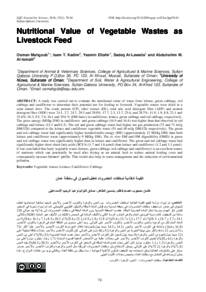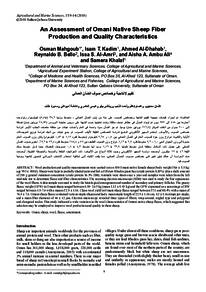Document
Nutritional value of vegetable wastes as livestock feed.
Identifier
DOI: http://dx.doi.org/10.24200/squjs.vol23iss2pp78-84
Source
Sultan Qaboos University Journal for Science. v. 23, no. 2, p. 78-84.
Contributors
Kadim, Isam T. , Author
Eltahir, Yasmin., Author
Al-Lawatia, Sadeq., Author
Al-Ismaili, Abdulrahim M. , Author
Other titles
القيمة الغذائية لمخلفات الخضروات كعلف للحيوان في سلطنة عمان.
Country
Oman.
City
Muscat
Publisher
College of Science, Sultan Qaboos University.
Gregorian
2018-12-30
Language
English
English abstract
A study was carried out to evaluate the nutritional value of waste from lettuce, green cabbage, red cabbage and cauliflower to determine their potential use for feeding to livestock. Vegetable wastes were dried in a solar tunnel drier. The crude protein (CP), ether extract (EE), total ash, acid detergent fiber (ADF) and neutral detergent fiber (NDF) were 24.1, 2.7, 24.7, 29.3 and 29.0%; 17.7, 2.3, 13.7, 25.6, and 28.7%; 11.9, 1.9, 8.8, 23.1 and 25.6%; 10.3, 0.5, 7.0, 16.1 and 19.6 % (DM basis) in cauliflower, lettuce, green cabbage and red cabbage, respectively. The gross energy (MJ/kg DM) in cauliflower and green cabbage (16.9 and 16.6) was higher than that observed in red cabbage and lettuce (14.1 and14.3). The red and green cabbage waste had higher net gas production (73 and 71 ml/g DM/12h) compared to the lettuce and cauliflower vegetable waste (51 and 48 ml/g DM/12h respectively). The green and red cabbage waste had significantly higher metabolizable energy (ME) (approximately 12 MJ/kg DM) than both lettuce and cauliflower waste (approximately 9 MJ/kg DM). The in vitro DM and OM digestibility (OMD) in green and red cabbage waste was significantly higher than in lettuce and cauliflower. The green and red cabbage waste had significantly higher short chain fatty acids (SCFA) (1.7 and 1.6 µmol) than lettuce and cauliflower (1.2 and 1.1 µmol). It was concluded that leafy vegetable waste (lettuce, green cabbage, red cabbage and cauliflower) is an excellent source of nutrients which can potentially be used after drying as an animal feed to reduce animal feeding costs and consequently increase farmers’ profits. This would also help in waste management and the reduction of environmental pollution.
ISSN
536-2414 X
Arabic abstract
أجريت دراسة لتقييم القيمة الغذائية لمخلفات الخس والملفوف الأخضر والملفوف الأحمر والقرنبيط لتحديد استخدامها المحتمل لتغذية الماشية. تم تجفيف مخلفات الخضروات في مجفف نفق شمسي. كان البروتين الخام (CP) ومستخلص الأثير (EE) والرماد الكلي وألياف المنظفات الحمضية (ADF) وألياف المنظفات المحايدة (NDF) 24.1 و 2.7 و 24.7 و 29.3 و 29.0٪ ؛ 17.7 و 2.3 و 13.7 و 25.6 و 28.7٪ ؛ 11.9 و 1.9 و 8.8 و 23.1 و 25.6٪ ؛ 10.3 و 0.5 و 7.0 و 16.1 و 19.6٪ (على أساس المادة الجافة) في القرنبيط والخس والملفوف الأخضر والملفوف الأحمر على التوالي. كانت الطاقة الإجمالية (MJ/kg DM) في القرنبيط والملفوف الأخضر (16.9 و 16.6) أعلى من تلك التي لوحظت في الملفوف الأحمر والخس (14.1 و 14.3). كان لنفايات الملفوف الأحمر والأخضر إنتاج غاز صافٍ أعلى (73 و 71 مل / جم DM / 12 ساعة) مقارنة بنفايات الخضروات من الخس والقرنبيط (51 و 48 مل / جم DM / 12 ساعة على التوالي). كان لنفايات الملفوف الأخضر والأحمر طاقة استقلابية (ME) أعلى بكثير (حوالي 12 ميجا جول / كجم DM) من كل من نفايات الخس والقرنبيط (حوالي 9 ميجا جول / كجم DM). كانت قابلية هضم المادة الجافة والمواد العضوية (OMD) في المختبر في نفايات الملفوف الأخضر والأحمر أعلى بكثير من تلك الموجودة في الخس والقرنبيط. أظهرت نفايات الملفوف الأخضر والأحمر ارتفاعًا كبيرًا في الأحماض الدهنية قصيرة السلسلة (SCFA) (1.7 و 1.6 ميكرومول) مقارنة بالخس والقرنبيط (1.2 و 1.1 ميكرومول). وخلصت الدراسة إلى أن نفايات الخضروات الورقية (الخس والملفوف الأخضر والملفوف الأحمر والقرنبيط) تعد مصدرًا ممتازًا للعناصر الغذائية التي يمكن استخدامها بعد التجفيف كعلف للحيوانات لتقليل تكاليف تغذية الحيوانات وبالتالي زيادة أرباح المزارعين. وهذا من شأنه أيضًا أن يساعد في إدارة النفايات والحد من التلوث البيئي.
Category
Journal articles


